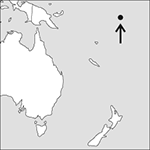
Source: MAPS IN MINUTES™ © RH Publications (1997)
Capital:
Funafuti
Area:
26 sq km (10 sq miles)
Population:
10,698 (2013 est)
Currency:
1 Tuvalu dollar = 100 cents; Australian currency is also legal tender
Religions:
Church of Tuvalu 97.0%; Seventh-Day Adventist 1.4%; Baha’i 1.0%
Ethnic Groups:
Polynesian 96.0%; Micronesian 4.0%
Languages:
Tuvaluan, English (both official); Samoan; Kiribati
International Organizations:
UN; Commonwealth; Pacific Islands Forum; Secretariat of the Pacific Community
A country comprising a scattered archipelago of small islands between Kiribati and Fiji in the South Seas.
Physical
Funafuti is the chief island in the group, which numbers nine, all of them coral atolls. Vegetation consists mainly of coconut palms.
Economy
Tuvalu has few natural resources and the principal economic activities are subsistence farming and fishing. The only exports are copra and fish. The main sources of national income are remittances from expatriates, a trust fund, fishing licences, and leasing Tuvalu’s national Internet suffix (.tv).
History
The first settlers probably came from Samoa and Tonga in the 14th century ad. The islands were sighted by Spanish explorers in the 16th century. They were formerly called the Ellice Islands after a 19th‐century British shipowner, Edward Ellice. In the 19th century whalers, traders, missionaries, and ‘blackbirders’ (Kanaka catchers) for the Queensland sugar plantations began to take an interest in these atolls, which the British were to include in the Gilbert and Ellice Islands Protectorate in 1892. In 1974 the Ellice Islanders, who are of Polynesian descent, voted to separate from the Micronesian Gilbertese. They achieved independence in 1978, establishing a constitutional monarchy. Tuvalu was admitted to the UN in 2000. The islands, which are at no point more than 4 metres above sea-level, are particularly vulnerable to global warming. The population of Tuvalu has been offered refuge in Fiji.
- allele
- allele frequency
- allelic exclusion
- allelochemical
- allelomorph
- allelopathy
- Allen, Andrew Michael (1955– )
- Allenby, Edmund Henry Hynman, 1st Viscount (1861–1936)
- Allende meteorite
- Allende, Salvador (1908–73)
- Allen, Edgar
- allenes
- Allen, Ethan (1738–89)
- Allen, James Alfred Van
- Allen, Joseph Percival, IV (1937– )
- Allen, Sir Roy George Douglas (1906–83)
- Allen Telescope Array
- Allen’s rule
- allergen
- allergy
- Allerød
- Allgemeines Statistisches Archiv
- Allied Intervention, War of
- all in one search engine
- allocation problem